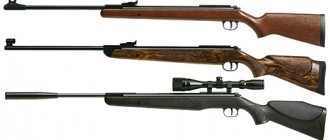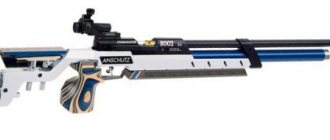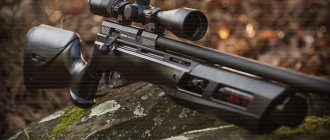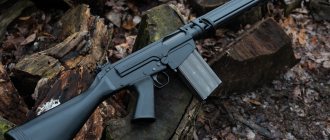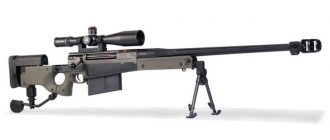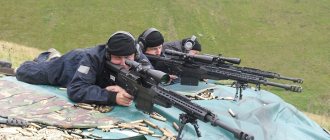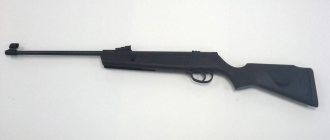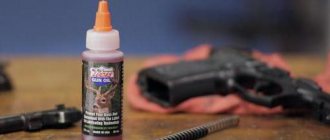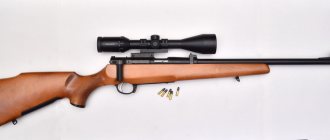The main purpose of a sniper rifle is to effectively hit a target at a long distance, and today every army in the world has a unit equipped with this type of weapon.
In addition to the characteristics of the firing range, rifles must provide high accuracy and significantly increase the lethal effect. Considering these characteristics, we will present the top best sniper rifles, both domestic and foreign made.
11
Anzio 20mm rifle. USA
Among the modifications of small arms of the Anzio Iron Works corporation, the Anzio 20mm rifle is the most powerful sniper rifle in the world.
The caliber of this most powerful monster is 20 mm, and the manufacturer declared a firing range of over 4500 meters. It is simply unrealistic to aim from a prone position, since the target, at such a distance, will be beyond the horizon.
Experts, after the appearance of such a giant, raised questions about the feasibility of such a product. The weapon turned out to be very heavy and large-sized.
10
L42 Enfield. Great Britain
The L42 Enfield model on display is undoubtedly the best in the excellent range of British guns. It is versatile among shortened weapons, as well as reliable and quite powerful.
The history of this weapon began at the end of the 19th century, and today the British army is armed with the latest and high-tech examples.
The Dano has gained popularity among snipers, and its widespread use is due to the fact that it is capable of hitting a target accurately from a distance of 1.8 kilometers, although it is worth noting that the effective range is only 1,000 meters.
9
Pros and cons of rifled semi-automatic machines
Many people know about the advantages of a rifled rifle over smooth-bore guns - this is the starting speed of the bullet, accuracy, accuracy and increased maximum combat distance. However, not everyone knows about the disadvantages. Firstly, this is a lower chance of hitting a high-speed target when fighting in comparison with shot, with which it is much easier to hit. Secondly, a rifled self-loading carbine is more difficult to maintain. In addition, smoothbore calibers are more versatile and easier to choose.
Hunters have different opinions about the advantages and disadvantages of rifled barrels: some like bullets, others like shot. Most hunters have both types of weapons.
SR-25. USA
In the 90s of the last century, designer Eugene Stoner developed a self-loading rifle, which over time became the main weapon of American special forces.
The rifle with automatic gas exhaust has undergone combat tests in Iraq and Afghanistan. It is now in service with the United States and Poland. Experts note the ease of use, as well as good technical performance, including its ability to effectively hit a target from 800 meters.
The loading and trigger mechanism allows not only automatic firing, but also single shots.
8
Site about weapons, weapons of all times and peoples, types of weapons
With the exception of military and air assault rifles, which are surprisingly growing in popularity, self-loading rifles are in decline. They lost their appeal due to their low accuracy, poor trigger mechanism and unsatisfactory balance. Inelegant outlines and an inflated price also played a role.
The sales lead undoubtedly belongs to Remington, sold under a variety of “nicknames.” Currently in production is the M4 for the buyer with a deep pocket, the Model 7400 for the buyer with big aspirations but with a mortgage on the house and an unpaid car, and the Sportsman 74 for the modest hunter. I prefer the latter. It does not shine with external decoration, but it shoots no worse than its “high-ranking” brothers. Unfortunately, the Sportsman 74 is only chambered in .30-06 (not that the six isn't good, but I like the choice).
Browning's BAR is the “cream” of the self-charging society. The rifle is large but well balanced, the comb height matches the telescopic sights well, shoots like crazy, and generally has an acceptable (and sometimes excellent) trigger pull.
I've shot about a dozen rifles chambered for the 7mm Remington Magnum cartridge, and my BAR was the second most accurate. Four five-shot series produced a spread of 1.2 inches (30.48 mm). Of the nine handloaded rounds, six produced an average spread of 1.875 inches (47.6 mm). This is an incredible result.
Finally, let's look at the Heckler-Koch Model 770. My copy of this model in .308 Winchester ten years ago was tested for Guns Illustrated magazine and showed accuracy of fire with a factory load of 1.5 inches (38 mm) and no worse than 2 inches (51 mm) with any other. This is the best result I have ever achieved while shooting an automatic weapon. The trigger pull is also light.
The connections between the metal parts of the rifle and the wooden parts can be called “so-so” at best, and in some places downright bad. The absurdly raised comb of the butt allows the use of only open sights, and your aesthetic senses are warped by the sight of square holes on the receiver intended for mounting a detachable optical sight. The optical sight was designed by a “layman” or, at least, by someone who not only had never hunted, but had not even read about hunting. With a telescopic sight installed, the only possible position is for the chin to be on top of the buttstock comb. The fuse is located very poorly. If Heckler & Koch had hired someone who knew something about hunting, about stocks and about the use of optical instruments, as well as about easily accessible fuses, they would have worked out something. For now, forget about Heckler & Koch's Model 770.
Related posts:
- None Found
AS50. Great Britain
The large-caliber rifle was the result of the work of a design bureau and is produced by the world's most famous arms manufacturer. One of the fastest-firing weapons of this type, capable of firing 5 rounds in 1.6 seconds.
Experts also include the firing range as an advantage of this model, because the rifle is capable of hitting a target at a distance of 1800 meters. It weighs 13.4 kilograms, and its working length is 1,369 millimeters.
Today the AS50 is equipped with special units of the British Army, and a small batch has also been purchased by the United States.
7
Characteristics of the air rifle EDgan Leshiy 2.0 (6.35 mm, 250 mm)
| Manufacturer | EDgun |
| Combat prototype | No |
| View | Pneumatic rifle |
| Type | PCP pneumatics |
| Caliber | 6.35 mm |
| Speed | 250 m/s |
| Type of ammunition | Lead bullets |
| Barrel type | Threaded |
| Number of charges | 8 pcs |
| Shooting mode | Semi-automatic |
| Gearbox | Eat |
| Energy source | High pressure receiver |
| Receiver volume | 266 cm3 |
| Fuse | Eat |
| Sighting rail Weaver (Picatinny) / Dovetail 11 mm | Eat |
| Housing material | Metal |
| Stock material | Plastic |
| Color | Black red |
| Size | Length - 633 mm, with the butt folded - 351 mm, barrel - 250 mm |
| Weight | 1.516 kg |
| Country of Origin | Russia |
| Equipment | Rifle, packaging, filling nozzle, brief documentation, copy of certificate (upon buyer's request), spare parts set of rubber bands, 2 magazines |
Air rifle EDgun Leshiy 2.0 (6.35 mm, 250 mm) buy in the Popadiv10 online store. Air rifle EDgun Leshy 2.0 (6.35 mm, 250 mm) at a low price of RUB 79,000. You can pay for your order by mail upon receipt in any part of the Russian Federation. Before placing an order, be sure to check the price and contents of the product by phone (during business hours) or by e-mail and feedback system (at any time convenient for you).
M21. USA
The self-loading rifle was developed back in the mid-60s of the twentieth century, but due to its excellent performance and technical characteristics, it continues to be in service.
The target firing range is 850 meters, and the magazine holds twenty rounds of the so-called “NATO model”, 7.62×51 caliber. You can use other cartridges, but this affects the firing range and accuracy.
It entered service with the US Army in 1969 and was widely used by the Americans in the Vietnam War and other conflicts in which the United States of America was involved.
6
From smoothbore guns to perfect small arms
Despite the fact that handguns appeared in the 13th century, only in the 19th century did their technical condition begin to change. The long path of development of small arms from smooth-bore guns to rifled fittings, rifles and carbines has been covered in just a few decades. The military rifle began to equip armies, replacing long and clumsy smooth-bore guns. At first, samples of small arms of conventional and standard calibers entered service. Later, due to changes in the methods and methods of armed confrontation in tactical terms, the division of rifles into small-caliber and large-caliber models began.
The rifle owes its name to the design of the barrel. Due to the special grooves in the barrel bore, a screw effect is created when fired. When fired under the pressure of powder gases, the bullet was unscrewed from the barrel, acquiring a stable axial position during flight.
With this scheme, the accuracy and range of the shot increased significantly, but the imperfection of the loading mechanism and firing mechanism did not allow further improvement of small arms. Only the invention of the primer and the mechanism for loading from the treasury gave impetus to the subsequent development of rifled firearms. The appearance of a unitary cartridge, which was chambered through simple manipulations by the shooter, became a key moment in the history of rifle development. These technical innovations make the weapon compact and quick-firing. The battle rifle becomes a practical, convenient and effective weapon for the infantryman, increasing the firepower of the infantry.
A review of the development of the small arms market in the middle and end of the 19th century indicates a search for optimal mechanisms for weapons of this type. Both in Europe and overseas, active work is underway to create the main weapon of the infantryman. In view of this, the design of the rifle changes radically, the weapon becomes more accurate, and its rate of fire increases. Rifling is becoming a mandatory element of firearms, and the design of the trigger mechanism is changing. If America became the birthplace of revolvers, then Europe can rightfully be considered the homeland of linear small arms. It was in European countries that the first examples of a perfect firing mechanism appeared. Dreyse needle rifles of the 1849 model entered service with the armies, with which the Prussian army achieved success in the war with Austria and Denmark.
The design of needle rifles was not ideal, so other systems soon appeared. In France, this is the Chassepot rifle; in England, the Carle rifle is being created. However, technological progress does not stand still. Next comes the turn of a more advanced system. The American Civil War (1861-65) became a testing ground for testing new weapons, among which small arms occupied an important place. Using combat experience, American officer Hiram Berdan invented a bolt-action rifle, which became the main model of small arms for the coming years. This system became popular in Russia, where the Berdan rifle became the main weapon of the Russian army in the 19th century. With these innovations, firearms have evolved rapidly. The calibers changed, which increased the power of the rifle, accordingly the firing range increased and accuracy increased. The rearmament of armies with new types of small arms begins. The time for combat smoothbore rifles is irrevocably gone.
Smoothbore guns are becoming a part of the hunting industry, turning over time from a military weapon into a purely civilian attribute. Thanks to technological progress, the production of hunting rifles is turning into a separate industry. A whole subculture emerges, in which its own fashion trends appear, its own traditions and schools are formed. Hunting rifles will also, over time, take their rightful place in human life, making hunting a profitable craft.
The development and perfection of hunting weapons was a consequence of the development of individual firearms, which became a mandatory attribute of a military man. A fierce struggle begins in the world between the European and overseas design schools. German and American gunsmiths are becoming trendsetters in the field of handguns. A superficial review of American rifles and an analysis of the European market demonstrate the direction in which the development of the arms industry in the world was going. As a result, a certain model range is outlined, in which the best rifles are systems created in America, Germany, England and Russia. With these weapons, the armies of the leading countries of the world are entering a new, rapid and bloody 20th century.
PSG1. Germany
The letter designation of this weapon is literally translated from German as “precision sniper rifle,” and its effective firing range is 900 meters.
The famous weapons company Heckler & Koch received an order from the government to produce effective weapons that would be universal for both the military and the police. The result of the work was the release of “PSG1” in 1972.
It is still in service with the Bundeswehr and is also exported to other countries around the world.
5
Dragunov rifle. USSR
For everyone, this sniper rifle is known under the abbreviated name “SVD”. All over the world, the SVD has long been recognized as one of the most reliable and effective among similar models of sniper weapons.
Design began in the early 1950s, and already in 1958 a prototype was presented. After testing, the first samples entered the army of the Soviet Union in 1963, and are still in use today. This indicator only confirms the excellent qualities of a sniper weapon.
The Degtyarev model, capable of effectively hitting a target from a distance of 1,200 - 1,400 meters, is in service in the armies of more than 50 countries.
4
Mosin rifle. Russia
For a long time, the invention of a Russian inventor and designer, the Russian three-ruler caliber 7.62, remained the best example of small arms in the whole world until the 30s of the last century.
The first samples entered the army in 1891, and its last version was of the carbine type, and released in 1944. It was designed in such a way that it could be used in both rain and snow, and it also shot perfectly when the parts of the body and bolt mechanism were dirty.
The most interesting thing is that even today museum samples are capable of accurately hitting a target from a distance of up to 1 thousand meters.
3
Review of the best models of individual small arms
Despite the fact that there was no alternative to rifled small arms under the current conditions, the first samples of rifles went through the entire cycle of childhood growth. Some systems replaced others, proving their superiority on the battlefield.
The first significant step towards improving small arms was the appearance of a unitary cartridge equipped with a metal sleeve. This equipment significantly simplified the loading system for rifles, which became faster-firing and more practical to use. Single-shot models are first replaced by multi-shot, repeating rifles. Wedge and swing gates are gradually disappearing from the scene. They are being replaced by longitudinally sliding valves. The Mauser brothers from Germany were the first to create new small arms for the new unitary cartridge. The German Gewehr 1871 rifle, model 1971, was a perfect weapon for its time. The French did not lag behind the Germans, and the following year they managed to create something similar. Only the Americans continued to produce their signature weapon, the Winchester Model 1873 rifle, equipped with a lever action. It cannot be said that the American Winchester became a full-fledged combat rifle; the weapon was recognized rather at the social and everyday level, rightfully earning the fame of the conqueror of the “Wild West”.
Starting from the end of the 19th century, multi-shot rifles began to enter service. In Russia, where previously they mainly focused on foreign models of small arms, their own developments are appearing. The most successful can be called the 7.62 mm repeating rifle of the Mosin system, which was adopted by the Russian Imperial Army in 1891. Following them in the USA, the Winchester M1895 rifle becomes the main weapon of the American army; in England, a more powerful and advanced Lee-Enfield Mk.3 rifle was created. In Germany and Austria-Hungary, the Mauser G 98 and Steyr Mannlicher M95 repeating rifles are supplied to army units.
From this point on, the design of the rifle becomes, in most cases, the same type. A sliding bolt was adopted as the main loading and reloading mechanism. The store becomes a mandatory design element. Only the calibers of military weapons differ, which go through their own stage of evolution in each country.
The stage has come for the technical re-equipment of the infantryman's weapons with more powerful models of individual small arms. The American famous Winchester and the Russian single-shot Berdanka are becoming a hunting type of rifled firearm. In the form that the combat rifle received at the turn of the 19th and 20th centuries, the weapon has survived to this day. The best samples were tested by fire during the First World War. Improved models, already in the form of carbines and sniper rifles, took part in the battles of the Second World War. The principle of operation remained the same when only the technical equipment of the weapon and its caliber changed.
L115A3 AWM. Great Britain
The rating of the most powerful and reliable rifles continues with the British-made L115A3 AWM weapon, which entered service with the Royal Army in the mid-80s.
Today it is recognizable in the world due to the fact that shooter designers actively use it in the development of new games. Among the technical characteristics, we note that it is equipped with optics that allow shooting both day and night.
It was actively used by British special forces during the war in Afghanistan, but the firing range of this model is 1,400 meters.
2
Greetings! As one of the first owners of the Evanix Max Air 2, I will write as objectively as possible the pros and cons of the rifle.The screw was purchased from Markuus, for which special thanks to him
I've had the screw for 3 days, I've already shot about two cans of JSB 1.645
In appearance, it’s not for everyone, but I personally like it, the butt is hard, non-slip soft-touch plastic, quite pleasant to the touch, and the handle is comfortable. The frame, as far as I understand, is painted aluminum. The butt plate is not adjustable. False moder with two cut-offs, outer diameter ~ 25mm
Performance characteristics: Weight more than stated - 3.8 kg
Total length 820mm
Barrel length 500 mm, barrel diameter 14 mm
Non-automatic fuse - slider
Steel tank, length 400mm, wall thickness 1.9mm, internal diameter ~ 30.9mm, pressure - up to 250 atm
The trigger has a regular firing pin + a gas engine (I’ll call it that), and there is a regular threaded plug for pressing the firing pin. The firing pin itself is rather large, with a powerful spring, and the cocking is very tight
There is a power adjustment in the form of a wheel that changes the diameter of the passage hole
There is a standard cover on the box made of thick soft rubber and a flimsy plastic bracket that can be used to cover the top and sides of the magazine to reduce blowing in the face. But the peculiarity of the mechanism is such that when shooting in the face it still blows and apparently nothing can be done about it.
The instructions specifically state that shooting at a pressure below 100 atm is prohibited, since there may not be enough power for self-cocking and this can lead to damage
The first shooting in chron with the above bullet at maximum throughput (I didn’t touch the hammer spring preload, the settings were the same) showed about 45 jesters in the corridor of 10 m/s (..56-..46 m/s) from 250 to ~ 170 atm
Repeated shootings gave approximately the same results in terms of the number of jesters, but at speeds of ..47-..37 m/s. I don’t know what’s causing it - perhaps the pressure plug was loosened
Heaps at 40 meters on the street and 50 meters in the shooting range in groups of 5 shooters are not bad - the best is 8mm, the worst is 25mm
There were no breakdowns or misfires, except for one time when the drum jammed, apparently due to a poorly inserted bullet, and once something like automatic fire occurred, but only one bullet flew out of the drum (i.e., when pressing SC, 5- 7 shots at a very high speed, but one bullet flew out, perhaps the drum did not have time to turn or the rammer did not open completely, in general, I still don’t understand what happened)
It came out of the box with a very tight and long cock, the problem was solved by adjusting it, as well as cutting the length of the spring on the trigger transfer rod.
Taking into account the fact that nothing has been done to the rifle yet and this is my first time with the rifle, I’m very pleased with the rifle overall!
Now what I didn’t like and what was done:
1. Short, heavy tank 2. The butt is attached to the receiver with one screw to a U-shaped bracket, which in turn is screwed to the receiver and the trigger transfer rod passes through this bracket. So, one of the holes in the bracket was drilled out of alignment, moved almost 4mm, which is why the bolt went obliquely, the butt was shifted back. Since this bracket is made of aluminum, I solved the problem with a small, simple drill 3. The aluminum frame is fixed at the bottom with a screw, which bluntly rests on the rubber (accordingly, there is a “beautiful” round scratch on the rubber), a second exactly the same scratch is on the front plug at the attachment point front eight. On a positive note, I noticed that on the front eight inside the upper part there is a rubber ring (similarly made on the Matador R5M, but there Eduard inserted a rubber ring into the lower part of the eight to compensate for the expansion of the rubber), apparently it simply protects the fake moder from scratches. In the rear eight, there are no rubber rings at all, but the rubber and false moder lie in it freely with gaps and its purpose is not entirely clear 4. The shaft of the striker and rammer were generously lubricated with some kind of very thick viscous lubricant - the excess was removed 5. The gas engine rod ( I’ll call it that) not polished, all in some kind of unevenness because of which it moved unevenly inside the striker - sometimes tightly, sometimes loosely, in general, I polished the rod with a felt circle with a goya, it no longer clings. On the front part of the rod you can already see traces of impacts during operation, as for me the metal of the rod is generally quite soft, I don’t know how long it will last, but I think the part is not very difficult for a normal turner if you make a new one later. 6. The body of the gas engine itself has recesses in the lower part for the clamping screws - so the Koreans apparently missed the first time, and on the second attempt they still made new recesses, leaving in parallel still decent scratches. In addition, the response holes in the box have sharp edges that scratch the rubber seals (there are cuts on both rings) - in the future I will try to smooth out the edges and somewhere I need to find suitable rubber rings 7. The hammer spring pressure plug is very easy to turn with your finger and is likely to occur when firing can be unscrewed little by little 8. The protective ring around the filling port and pressure gauge is fixed by two rubber bands, but their diameter is too small, which is why it is not fixed in any specific position, but rotates freely - I replaced one of the rubber bands with a slightly thicker one , now everything is fixed normally.
In principle, I think that no serious problems have been discovered yet.
The design is really quite simple and reliable, there’s nothing special to break and the parts don’t seem particularly difficult to manufacture, which raises the question of why the price is so high???)))
Future plans: 1. it is possible, but still questionable, to install a gearbox, especially since in the rear plug there is a plug for installing an additional pressure gauge to control the gearbox pressure and in the butt, apparently from older models, there is an inspection hole for the pressure gauge 2 I would like to lengthen the existing one or replace the entire rubber with a titanium one 3. Making an anti-bumper for the striker clamping plug (there is just enough free space in the butt to accommodate it)
CheyTac Intervention M200
In 2001, it began production of a large-caliber rifle capable of hitting a target from a distance of 2,000 meters.
This makes the model one of the longest-firing, and the shooting is also quite accurate. Gunsmiths around the world also note the reliability of the mechanism and the strength of the case.
This model perfectly combines excellent technical parameters with reliability and ease of use. During bench tests at the test site, the M200 effectively hit a target at a distance of 2300 meters.
1
Barrett 50 Cal
According to surveys of experts and the military directly, the Barrett 50 Cal, designed and manufactured by the American concern Barrett Firearms Manufacturing, is the best sniper rifle in the world.
Capable of effectively hitting targets from a distance of 1,560 meters, it is in service with many armies around the world. Let's also note the power of the weapon. The cartridge is capable of penetrating a wall at a distance of 2.6 kilometers.
The United States Department of War began purchasing them in 1989, and the Barrett 50 is widely used in armed conflicts around the world.
